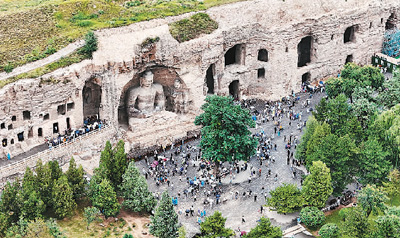'Black Myth' video game sparks tourism surge in China's Shanxi
The release of hit Chinese video game "Black Myth: Wukong" on Aug. 20 has sparked a tourism boom in north China's Shanxi Province, as players flock to real-world locations featured in the game.
The game depicts 36 locations across China, with 27 of them based on real places in Shanxi. Visitor numbers at these sites jumped 22 percent to 126,600 on Aug. 23 from the previous day, with tourism revenue rising 16.2 percent to 5.5 million yuan ($779,000).

Photo shows the Xuankong Temple in Datong city, north China's Shanxi Province. (Photo/Wang Fan)
The Culture and Tourism Department of Shanxi Province launched a "Traveling with Wukong in Shanxi" campaign on Aug. 22 to showcase the province's historical sites and cultural heritage.
The campaign features three themed routes and an eight-day self-driving tour, highlighting ancient architecture from the game and local cultural traditions.
The campaign offers free visits to ancient sites along the three themed routes for the first group of players to complete the game.
Wang Jing, a gamer from central China's Hunan Province, visited the Sakyamuni Pagoda of Fogong Temple in Yingxian county, a site featured in the game.
The pagoda, also known as the Yingxian Wooden Pagoda, was built in 1056 and is renowned for its tenon-and-mortise construction, a building technique that uses no nails or screws.

Photo shows the Sakyamuni Pagoda of Fogong Temple, also known as the Yingxian Wooden Pagoda, in Yingxian county, Shuozhou city, north China's Shanxi Province. (Photo/Wang Fan)
"Seeing the Yingxian Wooden Pagoda in person is a whole different ball game," Wang said. "Its timber structure exudes a sense of history that really strikes a chord."
After the game's release, searches for Shanxi on Douyin, a popular Chinese short-video app, increased about 80 percent compared to previous days. The hashtag "Traveling with Wukong in Shanxi" has garnered over 420 million views.
To draw tourists to visit sites featured in the game, the campaign features interactive "sign-ins" at ancient buildings. For instance, visitors can scan QR codes at temples like Chongfu, Foguang, Xiaoxitian and Yuhuang to complete questionnaires and receive a "travel pass." Twelve scenic spots, including the Yungang Grottoes and Shuanglin Temple, offer tourists cultural souvenirs.
Many scenic spots have adapted to the influx. For example, Mount Hengshan Scenic Spot offers free Wukong costumes for photos and themed souvenirs, said Yang Xinru, deputy director of the scenic spot's management center.
Tourist numbers have surged across Shanxi. The Yingxian Wooden Pagoda had attracted about 1.46 million visitors by Aug. 22 this year, up 178 percent from the same period last year.
The Yungang Grottoes saw 3 million visitors in the third week of August, exceeding last year's total.

Tourists visit the Yungang Grottoes in Datong city, north China's Shanxi Province. (Photo/Wang Fan)
The Xuankong Temple in Datong city received about 800 foreign tourists between Aug. 20 and Sept. 2, with foreign visitor numbers rising sharply after the game's release.
"We'll pull out all the stops to turn the 'Wukong effect' into a long-term appeal for visitors," said Wang Aiqin, head of the Culture and Tourism Department of Shanxi Province.
Photos
Related Stories
- China's relic-rich Shanxi ramps up heritage conservation
- China's coal-rich province sees 14.7-pct foreign trade growth in Jan-July
- Scenery of Taihang Mountain in China's Shanxi
- Daylilies grow into big industry in Datong, N China’s Shanxi
- Taiyuan aims to build key cultural, tourism destination
- Shanxi re-runs high school entrance exam English listening test after technical glitch
Copyright © 2024 People's Daily Online. All Rights Reserved.









